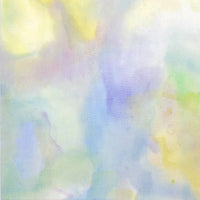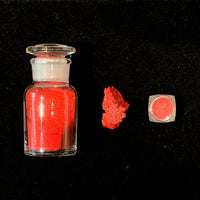Last Updated on: October 8th, 2025
In PIGMENT TOKYO, we have a large shelf that has a huge collection of pigments on display.
However, do you know how pigments have been used as art materials?
Culture and techniques cultivated based on one’s regional climate are linked to painting styles in many countries; the human desire to express with colors has not changed since ancient times. The ways of expressing with beautiful paints and preserving the paintings have developed through the wisdom and experience of our ancestors.
In Japanese culture, many kinds of paintings have been created with paints made based on our unique color senses. However, the process of making traditional Japanese paintings is not widely known.
Therefore, PIGMENT TOKYO offers workshops for everyone who wants to experience and enjoy learning traditional Japanese art materials and techniques.
In this article, I would like to introduce details of the workshop where you can learn by painting with mineral pigments.
Table of ContentsWorkshop OverviewWorkshop Program/Work ProcessLectureMaking an Artwork |
Workshop Overview

Introduction to Mineral Pigments (90 minutes)
Schedule: Once a month on Sunday
*The schedule may vary. Please check the reservation page for more information.
Time: 14:00 — 15:30
Venue: PIGMENT TOKYO
Fee: ¥6,600 (including tax and materials)
Age recommendations: Age 5 and up
Reservation: WORKSHOP–Introduction to Mineral Pigments
Things to bring: None
<Ticket Options (Please select if you need this option)>
◾️ Parent / guardian seat (1 person): free of charge
One additional chair will be provided.
*Please note that there is a limit to the number of chairs available.
*One parent/guardian is allowed to sit with one student per workshop.
*Materials are not included (You can assist the participant during the workshop).

◾️Others
*Animal glue is used in this workshop. Feel free to ask the instructor if you prefer plant-based gum arabic as an alternative.
*This workshop is lectured in Japanese, however, an English handout
will be provided for non-English speaking participants.
Workshop Program/Work Process
The pigments displayed on the wall include about 4500 colors made of natural ores and soil, as well as chemically synthesized organic and inorganic materials. The Nihonga (Japanese painting) technique handed down in Japan uses mineral pigments which are made of ores and soils, and another symbolic material, animal glue.
Through this workshop, PIGMENT TOKYO’s art materials expert will give a basic lecture about mineral pigments and how to use them.
You will make an A5 size (148mm×210mm) artwork by kneading paints and coloring in a pre-drawn flower panel.
Moreover, mineral pigments have different characteristics from other types of pigments.
The same material can produce different shades according to the coarseness of the pigment particles. This is a hands-on workshop to deepen understanding of these materials and their characteristics through experience.
It is ideal for those interested in painting with mineral pigments, its techniques and the materials used, as well as children who love painting and art materials.
This is an introductory course open to any purpose and experience level, including beginners who want to learn through making art and professional artists who wish to deepen their knowledge about art materials.
Without further ado, let's take a look at what we do in the workshop.
Lecture 14:00—14:20 (approx. 20 minutes)

During the lecture, you will learn about pigments and animal glue, the materials that are used to make paint called Iwa-enogu in Japanese.
There are natural pigments made from natural materials such as ores and soil, and synthetic pigments made artificially; these pigments are the source of color for not only Iwa-enogu, but also for watercolors, oil paints, acrylic paints and many other paints.
Mineral pigments are made by grinding ores into particles and dividing them into ten different particle coarseness. Even pigments from the same ore have different tones depending on the particle size. The grainy, sandy-like texture on the surfaces of ancient Japanese paintings is unique to Iwa-enogu.
Another important material for making Iwa-enogu is animal glue.
Animal glue is refined collagen by boiling down animal bones and skins. Today, animal glue might not be as common in our daily lives, but in the past, it was commonly used as a glue to bond wood and paper.
Moreover, animal glue is used as a binder to fix pigments on paper, silk and other substrates.
Among other types of binders, animal glue works excellently with water and its hygroscopicity changes its form according to temperature.
At low temperatures, animal glue is solid and when the temperature rises, it turns from a gel to liquid and can move back and forth between these states.
Therefore, it is the most suitable and flexible binder for storing and backing hanging scrolls in Japan, where temperature and humidity vary throughout the year.
This introductory workshop will explain pigments and animal glues, as well as the difference between pigments and dyes, in a way that even children and adults who are unfamiliar with art and materials will enjoy and can understand easily.
Making an Artwork 14:20 — 15:30 (approx. 70 minutes.)
After understanding Iwa-enogu, the instructor will demonstrate how to make it and everyone will have time to knead their paints too.
The instructor will show how to use the tools and give out tips on how to make the paints step by step.

Mineral pigments on the plum shape palette (color: Ginkomatsu, Yanagicha)
The mineral pigments on the plum shape palette are called Ginkohmatsu and Yanagicha in Japanese, and the colors remind me of Japanese sweets, wagashi. As you can see, these colors are rather gentle, yet rich and beautiful.
The three soft pink colors are Ginkohmatsu with the no.8, no.13 and no.byaku (white). Pigments with larger numbers have finer grains and paler color, and no.byaku is the brightest shade.
Now, let's see what these two types of pigments look like when you use them to paint the peonies.
*Floral motifs and pigment colors may vary depending on the season.

Kneading pigment and animal glue
Next, add animal glue to the pigments and knead with your fingertips to feel the graininess of the pigments.
While kneading pigments, you can imagine how you would like to color your painting. The art materials used in this workshop are the same as most artists used for their artworks.
Combining each pigment with animal glue and kneading together with fingers, and turning them into paints.
Animal glue, an essential ingredient in traditional Japanese paints, is made by cooking animal collagen. By experiencing it visually and physically through your fingers, you may be able to get a better idea of why animal glue is used for Iwa-enogu.
We recommend that parents/guardians assist young children when they join the workshops.
If you would like to help them make artwork, there is a "+ parent/guardian seat ticket" option, so feel free to select if that suits your needs.
*The option of a +parent/guardian seat ticket will be unavailable when the number of seats is reached due to space limitation.
*You’re not allowed to assist or stand to watch the workshop if you have not reserved a seat for a workshop or attendance option.
If you have any questions or concerns, please send us an email using the contact form below.

Finally, it is time for coloring.
If you love to color but are not confident in your painting skills, don't worry.
There will be pre-drawn sketches of peonies on the Japanese paper board, so all you need to do is to concentrate on filling in the peonies with color to the petals and leaves as you like.
If you have any questions about techniques, tools or materials, feel free to ask the instructor for assistance during the workshop.

The participants may take the artwork home with them and it would be fun to decorate your home with your art after the workshop.
You would never know what you might discover about the beauty of Japanese culture through experiencing traditional art materials and techniques!
PIGMENT TOKYO WORKSHOPS

Introductory Workshops
Schedule:
Introduction to Mineral Pigments (Once in a month/ Sundays)
Introduction to Metal Leaf (Once in a month/ Sundays)
Make Your Own Watercolors (Twice in a month/ Sundays)
WORKSHOPS–PIGMENT TOKYO
*The schedule may vary. Please check the reservation page for more information.
For reference, feel free to take a look at the following article for the basic information about private workshops (for individuals, companies, and organizations).
Private Workshop Information for Corporate and Organizational Clients
Private Workshop for Corporate Customers
PIGMENT TOKYO

![ワークショップ [入門]岩絵具で花をえがく](http://pigment.tokyo/cdn/shop/articles/KV-Mineral-Pigments-WS_52fb26b9-374e-4b8c-be7b-7011820e5a60.jpg?v=1762930012&width=1100)








